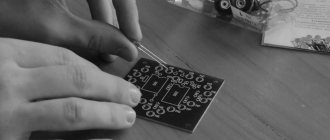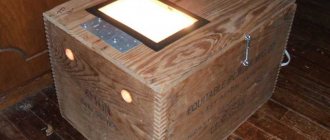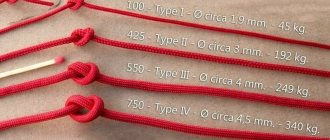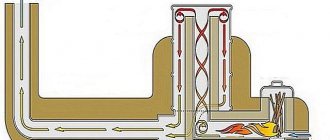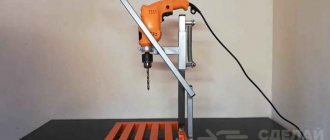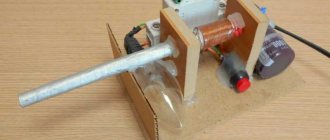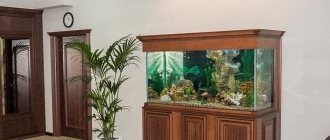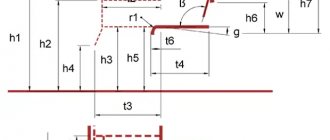Operating principle of LED device
The basis of the LED lamp is a single-sided semiconductor, the size of which is several millimeters. There is a unidirectional movement of electrons in it, which allows you to convert alternating current into direct current.
An LED crystal consisting of several layers is characterized by two types of electrical conductivity: positively and negatively charged particles.
The side containing the minimum number of electrons is called hole (p-type), while the other with a large number of these particles is called electron (n-type).
Between the two sides of the LED element there is a conventional boundary - an electron-hole junction (pn). Here the particles collide with each other, resulting in a glow.
When elements at a pn junction collide, they collide, generating light particles called photons. If you keep the system at a constant voltage during this time, the LED will emit a stable stream of light. This effect is used in all LED lamp designs.
Upgrading a halogen light bulb
Necessary materials:
- LED elements. The quantity is at your discretion, but preferably no more than 22 pieces, since it is difficult to work with a large quantity.
- Burnt out halogen light bulb.
- Super glue.
- Copper wire.
- Resistors.
- A piece of aluminum sheet, a regular beer can will do.
- Tools: hammer, soldering iron, hole punch.
Step-by-step instruction
- Remove the top halogen bulb. Use a screwdriver to remove the putty around the pin base.
- Using precise blows of a hammer, knock out the pins from their sockets so that the old light bulb falls out.
- Based on the number of diodes, make a plan of their location and print it out.
- Attach the paper stencil to an aluminum sheet and use a hole punch to knock out holes on it.
- Download on the Internet a diagram for connecting diodes depending on their number.
- Place the aluminum circle on the stand and insert light emitters into the holes. To facilitate the soldering process, you can immediately bend the cathode legs of the diodes to the anode legs of the others according to the diagram.
- Secure the light emitters in their seats with superglue, avoiding getting it on the legs of the LEDs.
- After the glue has dried, solder the legs according to the diagram. In this case, leave one negative and one positive leg for connection to the power supply. In order not to make a mistake in their polarity in the future, you can cut off the negative one a little.
- Solder resistors to the negative contacts. The result should be six positive and negative terminals (with resistors).
- Solder the resistors according to the diagram.
- Solder a piece of copper wire to the two contacts left for connecting to the power supply, which will become a pin base. One of them, the negative one, can also be made a little shorter so as not to confuse the polarity. The space between them must be glued so that a short circuit does not occur in the future.
- Install the structure on the reflector and glue it.
- Mark the positive and negative contacts with a marker. It is also advisable to note the voltage level: 12 V.
- Check the functionality of the product by connecting it to a car battery or 220/12 V power supply.
Four types of LED devices
Depending on the placement of LEDs, such models can be divided into the following categories:
- DIP . The crystal is arranged with two conductors, above which there is an enlarger. The modification has become widespread in the manufacture of signs and garlands.
- "Piranha" . The devices are assembled similarly to the previous version, but have four outputs. Reliable and durable structures are most often used to equip cars.
- SMD . The crystal is placed on top, which significantly improves heat dissipation and also helps reduce the size of the devices.
- OWL . In this case, the LED is soldered directly into the board, which increases the glow intensity and protects against overheating.
A significant disadvantage of COB devices is the impossibility of replacing individual elements, which is why you have to purchase a new mechanism due to a single failed chip.
Chandeliers and other household lighting products typically use SMD design.
Detailed instructions for assembling the LED lamp
Before starting assembly, you need to make sure the LEDs are working. It is also necessary to take into account that if the device is assembled incorrectly, it will not work.
In most cases, the structure does not want to work due to poor-quality soldering of the elements.
- Typically, a multimeter is used to measure voltage drop. In most cases, lamps are assembled to operate on a 12 Volt network. But the option under consideration will operate from a 220 V AC network.
- The largest glow can be obtained with a current of 20-25mA. If you buy inexpensive LEDs, they may produce a not very pleasant bluish light that is not very pleasing to the eyes. Therefore, it is better to dilute them with red elements, about four red ones per ten cheap ones.
The proposed option is not very complicated and does not require a driver, but is simply powered from a 220V network. The main disadvantage of this scheme is the lack of insulation of the elements, which can result in an electric shock. But still, if desired, it can be insulated.
LED lamp device
The LED lamp consists of the following six parts:
- Light-emitting diode;
- base;
- driver;
- diffuser;
- radiator.
The operating element of such a device is an LED, which generates a stream of light waves.
LED devices can be designed for different voltages. The most in demand are small products of 12-15 W and larger lamps of 50 watt.
The base, which can have different shapes and sizes, is also used for other types of lamps - fluorescent, halogen, incandescent. At the same time, some LED devices, for example, LED strips, can do without this part.
An important design element is the driver, which converts the mains voltage into the current on which the crystal operates.
The efficient operation of the lamp largely depends on this unit; in addition, a high-quality driver with good galvanic isolation provides a bright, constant luminous flux without a hint of blinking.
A conventional LED produces a directional beam of light. To change the angle of its distribution and provide high-quality lighting, a diffuser is used. Another function of this component is to protect the circuit from mechanical and natural influences.
The radiator is designed to remove heat, excess of which can damage the device. Reliable operation of the radiator allows you to optimize the operation of the lamp and extend its life.
The smaller this part, the greater the thermal load the LED will have to withstand, which will affect the speed of its burnout.
Advantages and disadvantages of a homemade lamp
Specialized stores offer a large selection of LED devices. However, sometimes it is impossible to find a device in the assortment that meets the necessary parameters. In addition, LED devices are traditionally high in cost.
Disadvantages of the products include the lack of a warranty from the manufacturer. In addition, if assembled carelessly, such devices may have an unattractive appearance.
Meanwhile, it is quite possible to save money and get the perfect lamp by assembling it yourself. This is not difficult to do and basic technical knowledge and practical skills will be enough.
A DIY LED device has a number of significant advantages over a store-bought analogue. They are economical: with careful assembly and the use of high-quality parts, the service life reaches 100 thousand hours.
Such devices show a high degree of energy efficiency, which is determined by the ratio of power consumption and the brightness of the light produced. Finally, their cost is an order of magnitude lower than their factory counterparts.
DIY problems
The main issues that have to be resolved in the manufacture of LED lamps are the conversion of alternating electric current into pulsating and its equalization to constant. In addition, it is necessary to limit the power flow to 12 volts, which is necessary to power the diode.
To create an LED lamp yourself, you can use parts purchased in specialized stores, or elements from burnt-out appliances
When thinking through the device, you should also solve a number of design problems, namely:
- how to arrange the circuit and LEDs;
- how to isolate the system;
- how to ensure heat exchange in the device.
Before assembly, it is advisable to think through all these problems, taking into account the requirements for a homemade light source.
Advantages of LED lamps
Today, LED is considered one of the most profitable efficient light sources. It is capable of creating a bright luminous flux at low powers, and also has a lot of other positive technical characteristics. It’s worth making your own flashlight from diodes for the following reasons:
- individual LEDs are not expensive;
- all aspects of assembly can be easily accomplished with your own hands;
- a homemade lighting device can run on batteries (two or one);
Note! Due to the low power consumption of LEDs during operation, there are many schemes where only one battery powers the device. If necessary, it can be replaced with a battery of appropriate dimensions.
- availability of simple diagrams for assembly.
LEDs and their glow
In addition, the resulting lamp will last much longer than its analogues. In this case, you can choose any color of the glow (white, yellow, green, etc.). Naturally, the most relevant colors here will be yellow and white. But, if you need to make special lighting for some celebration, then you can use LEDs with a more extravagant glow color.
LED lamp circuits
First of all, you should develop an assembly option. There are two main methods, each of which has its own pros and cons. Below we will look at them in more detail.
Option with diode bridge
The circuit includes four diodes that are connected in different directions. Thanks to this, the bridge acquires the ability to transform the mains current of 220 V into a pulsating one.
The LED bridge circuit is simple and logical. Even a novice master who has mastered the basics of independent work can perform it.
This happens as follows: when sinusoidal half-waves pass through two diodes, they change, which causes a loss of polarity.
During assembly, a capacitor is connected to the positive output in front of the bridge; in front of the negative terminal - a resistance of 100 Ohms. Another capacitor is installed behind the bridge: it will be needed to smooth out voltage drops.
Making an LED element
The easiest way to create an LED lamp is to make a light source based on a broken lamp. It is necessary to check the functionality of the detected parts, which can be done using a 12 V battery.
Defective elements must be replaced. To do this, you should unsolder the contacts, remove the burnt out elements, and put new ones in their place. In this case, it is important to observe the alternation of anodes and cathodes, which are attached in series.
If you need to change only 2-3 pieces of the chip, you can simply solder them to the areas where the failed components were previously located.
For complete self-assembly, you need to connect 10 diodes in a row, observing the polarity rules. Several completed circuits are soldered to the wires.
When making a lamp, you can use boards with LEDs, which can be found in burnt-out devices. It is only important to check their functionality
When assembling circuits, it is important to ensure that the soldered ends do not touch each other, as this can lead to a short circuit in the device and failure of the system.
Devices for softer light
To avoid the flickering characteristic of LED lamps, the circuit described above can be supplemented with several details. Thus, it should consist of a diode bridge, 100 and 230 Ohm resistors, 400 nF and 10 μF capacitors.
To protect the device from voltage surges, a 100 Ohm resistor is placed at the beginning of the circuit, followed by a 400 nF capacitor, after which a diode bridge and another 230 Ohm resistor are installed, followed by an assembled chain of LEDs.
Resistor devices
A similar scheme is also quite accessible to a novice master. To do this, you need two 12k resistors and two chains of the same number of LEDs, which are soldered in series, taking into account the polarity. In this case, one strip on the R1 side is connected to the cathode, and the other to R2, the anode.
Lamps made according to this scheme have a softer light, since the operating elements are lit in turn, making the pulsation of the flashes almost invisible to the naked eye.
To calculate the lamp power, you need to know the amount of current that passes through the LEDs. This value can be calculated using the given formula. It should be taken into account that the voltage drop in 12 LEDs connected in series is approximately 36V
The devices are successfully used as a table lamp and for other purposes. To create optimal lighting, experts recommend using strips of 20-40 diodes. A smaller number gives a small luminous flux; connecting a larger number of elements is technically quite difficult.
How to assemble it yourself?
Assembling an LED flashlight is not difficult if you have minimal skills in working with a soldering iron. For example, you can use an old personal computer motherboard and remove a “pocket” from it to hold the battery. This should be done carefully so as not to damage the surface and contacts.
The body of a small flashlight can be made from a syringe. To do this, use a paint knife to cut off the cone on which the needle is installed and remove the piston.
To avoid overheating of the LED, a radiator must be cut from an aluminum plate to the size of the lens. Using superglue, the lens holder housing is connected to the aluminum heatsink.
Solder the diode contacts with copper wire. As insulation, you can use a thermal casing and a lighter.
The part with the lens and LED should be secured with glue to the body of the syringe.
We connect the LED contacts to the battery contacts and insert them into the structure.
If the charging module board does not fit into the remaining part of the syringe, it can be divided into two parts and connected together with tape. Broken contacts should be soldered with copper wire.
The microswitch must be connected through a resistor to the charging module board. The remaining contacts of the module are connected in accordance with the diagram.
After assembling the flashlight, a micro-USB connector and a switch button should remain on the surface. If the work is done correctly, such a flashlight will work for 10-12 hours on a single charge.
Important element: LED driver
For the correct operation of a DIY LED device, you need to resolve the issue with the driver. The layout of this unit is quite simple. The operating algorithm consists of passing an alternating current of 220V to the diode bridge through capacitor C1.
The rectified current goes to series-connected LEDs HL1-HL27, the number of which can reach 80 pieces.
The driver for a homemade LED device is assembled according to the diagram below. You can also use ready-made elements bp 3122, bp 2832a or bp 2831a
To avoid flickering and achieve a consistently even color, it is advisable to use capacitor C2, which should have as large a capacity as possible.
Housings for LED devices
Before assembly, it is important to decide where the assembled circuit will be placed.
There are several options for solving this problem - to place the device you can use:
- incandescent lamp bases;
- housings from burnt-out energy-saving or halogen lamps;
- hand-made devices.
The first option has an important advantage. When using it, it is easy to screw the assembled LED device into the socket, thereby ensuring heat exchange.
It should be noted that in addition to the obvious advantages, this method also has obvious disadvantages. The assembled structure does not have a very aesthetic appearance; in addition, in this case it is difficult to provide reliable insulation.
In order to use a burnt-out incandescent lamp to create an LED one, you must first carefully separate the glass bulb from the base and then remove the spiral. The assembled circuit is carefully placed in the resulting space, and a light bulb is fixed above the board.
A convenient and practical option is to place a homemade device in the body of an energy-saving lamp. To do this, you first need to disassemble the burnt-out device by removing the converter board from it.
The assembled diagram can be inserted using different methods:
- The diodes are placed in holes made in the lid under the glass bulb.
- The circuit can be placed inside the base, which guarantees heat exchange. In this case, LED elements are inserted and fixed into existing holes.
- The board can be hidden in the base. To carry out the process, it is convenient to use a regular plastic cap from a water bottle.
To place LEDs, craftsmen often use a hand-made circle of plastic or cardboard, in which holes are drilled for the diodes. When done carefully, such devices look quite aesthetically pleasing.
Another option is to use a halogen lamp housing. It is not widely used, since in this case it is not possible to screw the lamp into the socket. Nevertheless, a similar modification is used to make homemade indicators and other devices.
If you decide to use a light bulb body for your work, we recommend reading our other article, where we described in detail how to disassemble various types of light bulbs. For more details, follow the link.
Materials for making homemade products
In addition to the body, other elements will be required to create the lamp. These are, first of all, LEDs, which can be purchased in the form of LED strips or individual NK6 elements. The current strength of each part is 100-120 mA; voltage 3-3.3 V.
The assembly of some circuits involves the use of additional links, for example, a driver, so the set of components for each specific case is considered separately
You also need 1N4007 rectifier diodes or a diode bridge, as well as fuses, which can be found in the base of an old device.
You will also need a capacitor, the capacitance and voltage of which must correspond to the electrical circuit used and the number of LED elements used in it.
If you are not using a ready-made board, you need to think about the frame to which the LEDs are attached. For its manufacture, a heat-resistant material that is not metal and non-conducting electric current is suitable.
As a rule, such a part is made of durable plastic or thick cardboard. To attach the LED elements to the frame you will need liquid nails or superglue.
Required Parts
To assemble an LED flashlight with your own hands you will need:
- the body will be made of a plastic syringe with a capacity of 20 ml;
- three-watt LED with a supply voltage of 3.4 V;
- diverging lens;
- power button (micro);
- current limiting resistor 3 Ohm power 0.25 W;
- the TP4056 micromodule will be used to charge the battery;
- aluminum plate for making a radiator;
- connecting wires (copper);
- 3.7 V battery;
- double sided tape;
- superglue, glue gun, epoxy compound or liquid nails.
Assembling a simple LED lamp
Let's consider the implementation of a lamp in a standard base from a fluorescent lamp. To do this, we will have to slightly change the above list of materials.
In this case we use:
- old base E27;
- NK6 LEDs;
- driver RLD2-1;
- a piece of plastic or thick cardboard;
- Super glue;
- electrical wiring;
- soldering iron, pliers, scissors.
Initially, you need to disassemble the lamp. For luminescent devices, the connection of the base to the plate with tubes is carried out using latches. It is important to locate the fastening location and pry the elements with a screwdriver, which will allow you to easily disconnect the cartridge.
The process of assembling a homemade LED lamp is simple. A driver is inserted into the case from the old device, on top of which a board with LEDs is installed
When disassembling the device, extreme care must be taken so as not to damage the tubes that contain a toxic substance inside. At the same time, it is necessary to monitor the integrity of the electrical wiring connected to the base, as well as preserve the parts contained in it.
We use the upper part with connected gas-discharge tubes to make the plate necessary for connecting the LEDs. It is enough to remove the tubular elements and attach the LED parts to the remaining round holes.
To secure them securely, it is better to make an additional plastic or cardboard cover, which will serve to isolate the chips.
The lamp will use NK6 LEDs, each of which consists of 6 crystals with parallel connection. They allow you to create a fairly bright lighting device with a minimum of electricity consumption.
To connect each LED to the cover, you need to make two holes. They should be pierced carefully in strict accordance with the diagram.
The plastic part allows you to firmly fix the LED elements, while the use of cardboard requires additional fastening of the LEDs to the base using liquid nails or superglue.
Since the device is designed to use six LEDs with a power of 0.5 watts each, the circuit must include three elements connected in parallel.
A spectacular lamp can be created using LED strip. This element is inserted into a tube used for fluorescent lighting
In a design that will operate from a 220 V power supply, you need to provide an RLD2-1 driver, which you should purchase in a store or do it yourself.
To avoid short circuits, it is important to insulate the driver and board from each other using plastic or cardboard before starting assembly. Since the lamp barely heats up, there is no need to worry about overheating.
Having selected all the components, you can assemble the structure according to the diagram, and then connect it to the electrical network to check the glow.
The device, operating from a standard 220 V power supply, has low energy consumption and a power of 3 Watts. The latter figure is 2-3 times less than that of fluorescent devices and 10 times less than that of incandescent lamps.
Although the light output is only 100-120 lumens, the dazzling white color makes the lamp appear much brighter. The assembled lamp can be used as a table lamp or to illuminate a compact room, for example, a corridor or closet.
LED rechargeable flashlight circuit
Simple circuits with conventional lamps are energy-consuming. They have a weak luminous flux and lead to rapid failure of the lamps. To get rid of these disadvantages, more complex devices are used with batteries instead of batteries and LEDs that replace incandescent lamps.
To improve the performance of the flashlight, additional elements are included in its circuit:
- Charging is carried out from a 220 V network through a rectifier using a smoothing capacitor C1. The circuit is designed to convert some of the electricity into heat and limit the voltage applied to the battery.
- To indicate the charging process, the VD1 LED is included in the circuit.
- LEDs are used as load in the flashlight.
Conclusions and useful video on the topic
In the video below you can see a detailed description of a specialist about self-assembly of an LED lamp:
LED lamps, made independently, have high technical characteristics. They are almost as good as factory models in terms of qualities such as strength, reliability, and durability.
The assembly of such devices is accessible to almost everyone: to successfully complete it, you just need to strictly follow the diagrams and carefully carry out all the prescribed manipulations.
Perhaps you have already assembled an LED lamp with your own hands and can you give valuable advice to visitors to our site? Or did you have any questions after reading the article? Please leave your comments in the block below.
